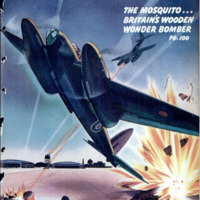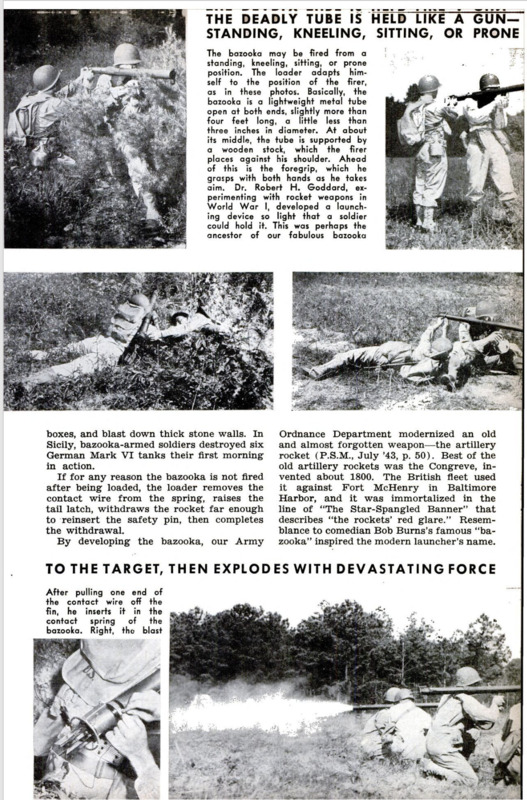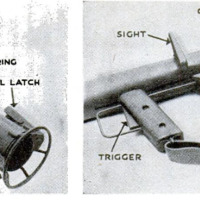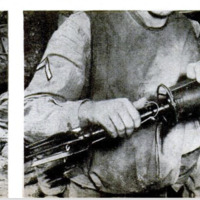The Uses of Bazooka
Item
-
Title (Dublin Core)
-
The Uses of Bazooka
-
Article Title and/or Image Caption (Dublin Core)
-
How the Bazooka Team Stops 'Em
-
extracted text (Extract Text)
-
THERE'S one thrill no soldier will ever
Forget first time he fires a bazooka.
This weapon (P.S.M., July '43, p. 110), so
long kept hush-hush, is unlike anything
else in warfare.
Normally, two soldiers form a bazooka
team, although one man can fire it unaided
in an emergency. The firer carries, aims,
and fires the rocket launcher, as the tube is
technically called. The loader carries the
projectile and loads the weapon.
First, the firer tests the electric-battery
circuit by pressing the trigger several times
and noting if a miniature bulb on the stock
flashes on and off.
To load, the loader grasps a rocket by its
tail and inserts its head into the tube. Next,
he removes the safety pin from the fuse.
Pushing the missile into the tube until the
tail latch at the breech engages a notch in
the fins, he pulls one end of the contact wire
off the tail and inserts it in the contact
spring on top of the tube near the breech.
That done, he snaps: “Ready to fire!”
The firer takes aim and presses the trigger.
This closes the electric circuit and sets off
an igniter inside the rocket. The propelling
charge lets go with a blast that shoots from
the rear end of the tube. This high-speed
jet of gas, which is generated by the pro-
gressive burning of the propelling charge
in the projectile itself, is what launches the
rocket and carries it to its target. There
is no recoil, but the loader must keep well
to one side of the open breech.
In the streamlined head of the rocket is
a high explosive. It is this that does the
damage. The effect of the explosion almost
defies description. It will knock out a tank
with a single shot, shatter concrete pill-
boxes, and blast down thick stone walls. In
Sicily, bazooka-armed soldiers destroyed six
German Mark VI tanks their first morning
in action.
If for any reason the bazooka is not fired
after being loaded, the loader removes the
contact wire from the spring, raises the
tail latch, withdraws the rocket far enough
to reinsert the safety pin, then completes
the withdrawal.
By developing the bazooka, our Army
Ordnance Department modernized an old
and almost forgotten weapon—the artillery
rocket (P.S.M., July ’43, p. 50). Best of the
old artillery rockets was the Congreve, in-
vented about 1800. The British fleet used
it against Fort McHenry in Baltimore
Harbor, and it was immortalized in the
line of “The Star-Spangled Banner” that
describes “the rockets’ red glare.” Resem-
blance to comedian Bob Burns's famous “ba-
zooka” inspired the modern launcher’s name.
-
Contributor (Dublin Core)
-
William W. Morris (photographer)
-
Language (Dublin Core)
-
eng
-
Date Issued (Dublin Core)
-
1943-12
-
pages (Bibliographic Ontology)
-
68-69
-
Rights (Dublin Core)
-
Public Domain (Google digitized)
-
Archived by (Dublin Core)
-
Matteo Ridolfi
-
Alberto Bordignon (Supervisor)
 Popular Science Monthly, vol. 143, n. 6, 1943
Popular Science Monthly, vol. 143, n. 6, 1943






